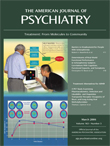A PET Study Evaluating Dopamine D2 Receptor Occupancy for Long-Acting Injectable Risperidone
Abstract
OBJECTIVE: Long-acting injectable risperidone represents the first clinically available depot atypical antipsychotic. The present study used positron emission tomography (PET) to evaluate its dopamine D2 binding profile at doses of 25, 50, or 75 mg administered every 2 weeks. METHOD: After achieving stabilization with one of the doses, nine patients with a diagnosis of schizophrenia or schizoaffective disorder underwent [11C]raclopride PET to measure D2 occupancy. Participants were scanned twice during the 2-week injection interval: within 3 days after injection (postinjection) and within 5 days before the next injection (preinjection). At the same time, plasma was collected for measurements of risperidone plus 9-hydroxyrisperidone. RESULTS: Mean post- and preinjection D2 occupancy levels for the 25-, 50-, and 75-mg doses were 71.0% and 54.0%, 74.4% and 65.4%, and 81.5% and 75.0%, respectively. There was a significant correlation between dose and plasma concentrations of risperidone plus 9-hydroxyrisperidone, and the estimated plasma concentration associated with 50% D2 occupancy (ED50) was 11.06 ng/ml. Prolactin levels were not correlated with drug levels or D2 occupancy. CONCLUSIONS: All three doses of injectable risperidone showed peak D2 occupancy levels above the 65% threshold associated with optimal clinical response; the 75-mg dose approximated the 80% threshold linked to increased risk of extrapyramidal symptoms. Doses of 25 or 50 mg should provide therapeutic efficacy while minimizing the risk of extrapyramidal symptoms.



